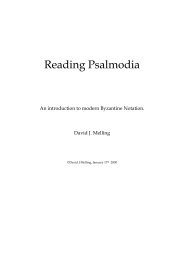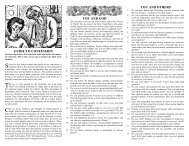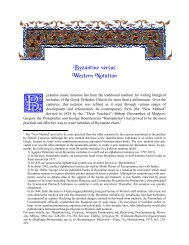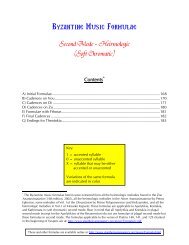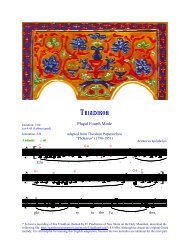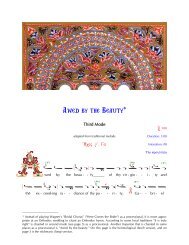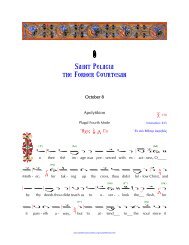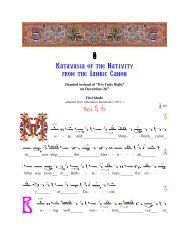The Intonations of the Eight Modes - St. Anthony's Monastery
The Intonations of the Eight Modes - St. Anthony's Monastery
The Intonations of the Eight Modes - St. Anthony's Monastery
You also want an ePaper? Increase the reach of your titles
YUMPU automatically turns print PDFs into web optimized ePapers that Google loves.
Appendix II<br />
<strong>The</strong> <strong>Intonations</strong> <strong>of</strong> <strong>the</strong> <strong>Eight</strong> <strong>Modes</strong> 1<br />
ROM earliest times, composers <strong>of</strong> Byzantine chant have identified each musical mode by a<br />
characteristic intonation formula (ajphvchma), a phrase normally sung in its entirety by <strong>the</strong><br />
protopsaltis (<strong>the</strong> lead chanter <strong>of</strong> <strong>the</strong> right choir) alone, without <strong>the</strong> ison. Its function is to<br />
help <strong>the</strong> chanters recall <strong>the</strong> ethos <strong>of</strong> a given mode before beginning <strong>the</strong> chant. Moreover, it also<br />
provides <strong>the</strong> choir with <strong>the</strong> pitch required for <strong>the</strong> first note <strong>of</strong> <strong>the</strong> piece.<br />
In Byzantine music, <strong>the</strong>re are eight modes and three modal genres: <strong>the</strong> diatonic, <strong>the</strong> enharmonic,<br />
and <strong>the</strong> chromatic. 2 Fur<strong>the</strong>rmore, each <strong>of</strong> <strong>the</strong> eight modes is broken down into three species,<br />
characterized by <strong>the</strong> number <strong>of</strong> notes typically attached to a syllable. A melody with one or<br />
two notes above a syllable is called “heirmologikon”; one carrying approximately three or four is<br />
called “sticherarikon”; and that having a dozen or more notes is called “papadikon.” In <strong>the</strong> first<br />
and third modes, <strong>the</strong> musical patterns are identical for each <strong>of</strong> <strong>the</strong>se three species. For <strong>the</strong> o<strong>the</strong>rs,<br />
however, <strong>the</strong> musical gestures differ significantly; hence <strong>the</strong> need for more than one intonation<br />
formula for each mode.<br />
<strong>The</strong> following pages contain <strong>the</strong> typical intonation formulas <strong>of</strong> all eight modes. Since <strong>the</strong><br />
vocal rendition <strong>of</strong> a given intonation varies greatly from chanter to chanter, those <strong>of</strong>fered here<br />
are primarily based on <strong>the</strong> investigations <strong>of</strong> <strong>the</strong> musicologist, George Constantinou. 3<br />
Some 4 F<br />
believe that <strong>the</strong> syllables <strong>of</strong> <strong>the</strong> intonations derive from <strong>the</strong> following penitential<br />
prayer (though in a slightly altered form): “a[nax, a[fe", nai; a[fe", a[nax a{gie”: “O King, forgive,<br />
yea forgive, O holy King.”<br />
According to current practice on <strong>the</strong> Holy Mountain, intonations, when used, are chanted<br />
during <strong>the</strong> Divine Liturgy only before “papadika” melodies (such as <strong>the</strong> cherubic hymn and <strong>the</strong><br />
communion hymn). In some Athonite monasteries, however, intonations are never heard, while<br />
in o<strong>the</strong>rs <strong>the</strong>y appear almost every time a modal alteration takes place.<br />
1 While most Orthodox liturgical books in English translate <strong>the</strong> word “h\co"” as “tone,” it is more accurate to use <strong>the</strong><br />
term “mode.” (Vid. Harvard Dictionary <strong>of</strong> Music, Revised Edition, Cambridge, Massachusetts, 1970, pp. 535,<br />
856.)<br />
2 Note that <strong>the</strong> term “chromatic scale” in Western music denotes <strong>the</strong> scale embracing twelve successive half tones to<br />
<strong>the</strong> octave, whereas in Byzantine music, it is a modal genre with a tonic on D, flats on E and B, and sharps on F<br />
and C. <strong>The</strong> term “enharmonic” in Byzantine music is synonymous with B Flat Major, whereas “diatonic” in Byzantine<br />
music is approximately <strong>the</strong> scale <strong>of</strong> C Major.<br />
3 Kwnstantivnou, Gewvrgio" N., Qewriva kai; Pravxh th'" !Ekklsiastikh'" Mousikh'", !Aqhvna, gV e[kdosi", 2001.<br />
4 Panagiwtopouvlou, Dhmhtrivou G., Qewriva kai; Pra'xi" th'" Buzantinh'" !Ekklhsiastikh'" Mousikh'". #Ekdosi"<br />
!Adelfovthto" Qeolovgwn ããO SWTHRÃÃ, !Aqh'nai, dV e[kdosi", sel. 45.
1<br />
2<br />
<strong>The</strong> <strong>Intonations</strong><br />
<strong>of</strong> <strong>the</strong> <strong>Eight</strong> <strong>Modes</strong> *<br />
First Mode<br />
Heirmologikon, <strong>St</strong>icherarikon, and Papadikon<br />
<br />
A ƒ+a ƒ~e"<br />
Ahƒ-ƒnah - ƒnes<br />
Papadikon from KE "tetraphonic"<br />
<br />
<br />
<br />
<br />
ƒA +a ƒ~e ƒe ƒƒe ƒƒe" ƒA ƒƒƒ+aƒƒƒ~e ƒƒa ƒƒ~e ƒƒƒe"<br />
Ah - ƒnah - nes___________________ ƒƒAhƒƒ-ƒnah-nehƒƒah-nes____<br />
_____________________________<br />
* To hear a recording <strong>of</strong> <strong>the</strong>se intonations chanted, please download <strong>the</strong> following 6.4 MB file:<br />
http://www.stanthonysmonastery.org/music/<strong>Intonations</strong>.mp3 <br />
or:
3<br />
4<br />
5<br />
6<br />
<strong>The</strong> <strong>Intonations</strong> <strong>of</strong> <strong>the</strong> <strong>Eight</strong> <strong>Modes</strong> 623<br />
Papadikon from KE "tetraphonic" (elaborate version) <br />
<br />
<br />
ƒA ƒƒa +a ƒƒ~e ƒe e e e ƒƒe ƒƒa ƒa ƒ~e e e ƒƒe ƒe<br />
ƒAh - - ƒnah - ƒƒƒne________________________ ƒah - - ƒnes_____________<br />
ƒe e e e e ƒƒe ƒe ƒe ƒ e ƒ ƒƒe ƒƒe" <br />
_____________________________________________________<br />
Heirmologikon, S<strong>of</strong>t Chromatic Scale <br />
ƒ~e ƒa ~e" <br />
Neh ah - ƒ nes<br />
Second Mode<br />
Heirmologikon, "Mesos" (with endings on VOU) <br />
<br />
ƒƒ~e ƒƒa a ƒ~e ƒe"<br />
ƒƒNeh ƒƒah - - ƒƒnes____<br />
Heirmologikon, Hard Chromatic Scale <br />
<br />
ƒƒ~e ƒa a ƒ~e"<br />
ƒƒNeh ƒah - - ƒƒnes
624<br />
7<br />
8<br />
9<br />
10<br />
<strong>The</strong> <strong>Intonations</strong> <strong>of</strong> <strong>the</strong> <strong>Eight</strong> <strong>Modes</strong><br />
<strong>St</strong>icherarikon and Papadikon, S<strong>of</strong>t Chromatic Scale <br />
or:<br />
ƒƒ~e ƒƒa a ~e ƒe" ƒ~e e e e ƒƒƒa ƒa ƒ~e e"<br />
ƒƒNeh ah - - ƒnes___ ƒNeh____________ ah - - ƒƒnes___<br />
<br />
Third Mode<br />
Heirmologikon, <strong>St</strong>icherarikon, and Papadikon <br />
<br />
ƒƒ+a a ƒƒ+a<br />
ƒƒNah - - nah<br />
Heirmologikon from VOU <br />
<br />
ƒƒ Le ƒƒge to"<br />
ƒƒLehƒ-ƒyeh-tos<br />
Heirmologikon from DI <br />
<br />
ƒƒ Le ƒƒƒƒƒge ƒe ƒƒƒto ƒo"<br />
ƒƒƒLeh - yeh - - ƒtos____<br />
Fourth Mode<br />
Heirmologikon, Hard Chromatic Scale <br />
<br />
ƒƒ~e ƒƒe ƒ+a ƒ+w<br />
ƒƒNeh - - ƒƒnah - no
11<br />
12<br />
13<br />
14<br />
<strong>St</strong>icherarikon <br />
<strong>The</strong> <strong>Intonations</strong> <strong>of</strong> <strong>the</strong> <strong>Eight</strong> <strong>Modes</strong> 625<br />
ƒƒ ƒƒA ƒƒƒƒƒ gi ƒƒƒa ƒƒA ƒƒƒƒƒ a ƒa ƒgi ƒƒƒa <br />
ƒƒƒAh - yee - ƒah ƒƒ ƒAh - - - - yee - ƒah<br />
Papadikon<br />
ƒƒ ƒƒA ƒƒƒƒƒ ƒgi ƒƒƒa ƒa ƒƒa ƒa a a ƒa a a a ƒa<br />
ƒƒƒAh - ƒyee - ƒah____________________________________________________<br />
<br />
a ƒa a a ƒa a ƒa<br />
ƒ_________________________________<br />
Heirmologikon <br />
<br />
<br />
A ƒ~e a ~e"<br />
Ah - ƒneh - ah-ƒnes<br />
<strong>St</strong>icherarikon and Papadikon <br />
<br />
A ƒƒ~e a ƒ~e"<br />
ƒƒAhƒ-ƒnehƒ-ƒƒah - - ƒnes<br />
or:<br />
Plagal First Mode
626<br />
15<br />
16<br />
17<br />
18<br />
<strong>The</strong> <strong>Intonations</strong> <strong>of</strong> <strong>the</strong> <strong>Eight</strong> <strong>Modes</strong><br />
<strong>St</strong>icherarikon and Papadikon (elaborate version) <br />
<br />
<br />
<br />
<br />
ƒa ƒ~e"<br />
- ƒ ƒƒnes<br />
ƒA a ƒƒ~e e e e ƒƒe ƒe e ƒa a ƒƒa a a ƒ+a ƒa aƒ<br />
ƒAh - - ƒneh - - - - - - - ƒƒah - - - - - - ƒnah - - -<br />
<strong>St</strong>icherarikon "tetraphonic" (with endings on KE) <br />
<br />
A ƒ~e a ƒƒƒ~e ƒƒe e ƒƒe"<br />
Ah - nehƒ-ƒ ah-nes__________________<br />
Heirmologikon, S<strong>of</strong>t Chromatic Scale <br />
<br />
~e ƒƒce ƒa a ƒ ƒ~e ƒƒe"<br />
Nehƒ-ƒhehƒ-ƒ ah - - nes____<br />
Plagal Second Mode<br />
Heirmologikon, S<strong>of</strong>t Chromatic Scale (elaborate version) <br />
<br />
<br />
~e ƒƒe ƒƒce a a ƒƒƒ~e e e ƒƒe"<br />
Neh - - ƒƒhehƒ-ƒ ah - - nes___________
19<br />
20<br />
21<br />
22<br />
Heirmologikon, Hard Chromatic Scale *<br />
ƒƒ~e ƒƒe ƒ+a ƒ+w <br />
<strong>The</strong> <strong>Intonations</strong> <strong>of</strong> <strong>the</strong> <strong>Eight</strong> <strong>Modes</strong> 627<br />
<strong>St</strong>icherarikon and Papadikon (Hard Chromatic Scale) <br />
<br />
Grave Mode<br />
Heirmologikon and <strong>St</strong>icherarikon (from GA) <br />
<br />
Papadikon (from ZO) <br />
<br />
<br />
ƒƒNeh - - ƒƒnah - no<br />
ƒƒ~e ƒe ƒƒce a a ƒ~e"<br />
ƒNeh - - ƒƒhehƒ-ƒ ah - - ƒƒnes<br />
ƒƒA ƒƒa ƒ~e"<br />
ƒ A - - ƒnes<br />
<br />
<br />
<br />
ƒƒ ƒƒ~e ƒƒe e ƒƒe e e ƒe e ƒe ƒƒe ƒe e e<br />
ƒ Neh_______________________________________________<br />
*<br />
This heirmologikon version <strong>of</strong> <strong>the</strong> hard chromatic scale actually belongs to fourth mode according to most<br />
musicologists.
628<br />
23<br />
24<br />
25<br />
26<br />
Papadikon (Enharmonic from ZO) <br />
<br />
Heirmologikon (from NEE) <br />
<br />
Heirmologikon (from GA) <br />
<strong>The</strong> <strong>Intonations</strong> <strong>of</strong> <strong>the</strong> <strong>Eight</strong> <strong>Modes</strong><br />
Plagal Fourth Mode<br />
<br />
or:<br />
<br />
<strong>St</strong>icherarikon and Papadikon <br />
<br />
<br />
<br />
ƒƒA ƒƒa ƒ~e"<br />
ƒ A - - ƒnes<br />
~e ƒ ƒƒa ƒgi ƒe<br />
ƒƒNeh ƒƒah - yee ƒeh<br />
~e eƒ ƒƒa ƒgi i ƒe<br />
ƒƒNeh____ ƒƒahƒƒ-ƒƒyee - - eh<br />
~e ƒƒa ƒ ƒa a ƒƒa gi ƒi ƒƒi i ƒƒe<br />
ƒƒNeh ƒahƒƒ- - - - -ƒƒƒyee - - - - eh<br />
ƒƒ+a a ƒƒ+a<br />
ƒƒNah - - nah<br />
<br />
<br />
~e ƒƒa ƒ a ƒa ƒ a ƒgi ~e ƒa ƒ ƒa ƒgi ƒƒi ƒe<br />
ƒƒNeh ƒahƒƒ- - - - - ƒyee ƒneh ƒƒah - ƒ- yee - ƒeh<br />
or:



